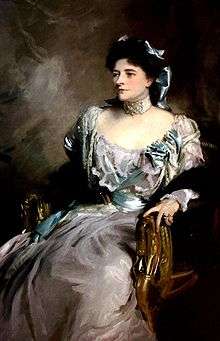Julius Wernher

Sir Julius Charles Wernher, 1st Baronet (9 April 1850 – 21 May 1912) was a German-born Randlord and art collector who became part of the English establishment.
Life history
Born in Darmstadt, Hesse, Wernher was the son of a railway engineer of Protestant stock. He was educated at Frankfurt-am-Main, where he entered a merchant bank. In 1871, having served in the Franco-German War, he moved to London at the age of 21. His talent for business was spotted by a diamond dealer named Jules Porgès of London and Paris, who sent Wernher in 1873 as his agent to the diamond mines of Kimberley, South Africa to buy and export diamonds. Wernher bought up mining interests and by 1875 was a member of the Kimberley mining board. In that same year, Porgès and Alfred Beit joined him in Kimberley, and Porgès formed the Compagnie Française des Mines de Diamants du Cap. Porgès returned to London after having made Wernher and Beit partners in the firm of Jules Porgès & Co. By 1884 Wernher returned to London and traded in diamond shares, while Beit remained in Kimberley to look after their interests. On Porgès' retirement in 1889, the firm was restructured and named Wernher, Beit & Co.
With the discovery in 1886 of gold on the Witwatersrand, the firm appointed Hermann Eckstein as their representative in Johannesburg, while Cecil Rhodes and Beit effectively amalgamated the Kimberley diamond mines by 1888 and enabled Wernher, Beit & Co. to acquire a controlling interest in De Beers Consolidated Mines. Wernher by now was managing over 70 South African companies from his London office, and developing a passion for collecting art. He was created a baronet in 1905, as well as being a member of the Order of the Crown of Prussia. Despite having a reputation for prudence in business, Wernher was swindled out of £64,000 in 1906 by Henri Lemoine, who claimed he could make synthetic diamonds.
Beset by failing health in 1911, Wernher merged the shareholdings of Wernher, Beit & Co. with those of Central Mining and Investment Corporation and Rand Mines Ltd. Besides his interest in art, Wernher funded an extension to the National Physical Laboratory. He also bequeathed £250,000 to establishing a university in Cape Town, and £100,000 to the Imperial College of Science and Technology in London.
At the time of his death in London, he was one of the richest men in the United Kingdom with a fortune of £12 million (then $60 million in face value, then about 20–30 times than in current purchasing power). This accumulation of wealth was due to his level-headedness and attention to detail. In contrast, Beit was shrewd but impulsive, leading to fiascos like the Jameson Raid.

Art
Wernher kept his art collection at his London mansion, Bath House in Piccadilly, and at his country house Luton Hoo (occupied by Robert de Hoo in 1245). Much of it is now on display at Ranger's House in the London suburb of Greenwich.[1] A large memorial to Wernher now flanks the entrance to the Royal School of Mines in London.
Marriage and children
On 12 June 1888 Julius married socialite Alice Sedgwick Mankiewicz (1862 – 30 November 1945), nicknamed "Birdie", whom he described as "bright-eyed, fair-haired, small, intelligent and musical". She was the daughter of Jacob "James" Mankiewicz (1830–1879) from Danzig, the son of Joel Mankiewicz, a Polish-Jewish merchant. Her mother was Ada Susan Pigott from Colchester, who had a brother who was a General. Birdie and her mother lived in part of a big mid-Victorian house in Bayswater, 15a Pembridge Square. Julius and Alice had three sons:
- Sir Derrick Julius Wernher, 2nd Baronet (7 June 1889 – 6 March 1948) x 14 December 1922 Theodora Anna Romanoff, daughter of Nikita Romanoff (from an exiled Russian noble family – non related with the Imperial House of Romanov – whose member was in charge of the enterprise of "Sibirsky telegraf", "The Siberian Telegraph", in 1861)[2]
- Anna Alexandra Wernher (14 May 1924 – May 2010)
- Alexander, killed in World War One.
- Maj.-Gen. Sir Harold Augustus Wernher, 3rd Bt. (16 January 1893 – 30 June 1973) x Countess Anastasia (Zia) Mikhailovna de Torby, (9 September 1892 – 1977), daughter of Grand Duke Michael Mikhailovich of Russia and Sophie Nikolaievna von Merenberg, Countess de Torby
- Captain George Michael Alexander Wernher (22 Aug 1918 Edinburgh, Midlothian, Scotland – 4 December 1942 Beja, Egypt). Killed in action
- Georgina Wernher (b. 17 October 1919 Edinburgh, Midlothian, Scotland) × London 10 October 1944 Lt.-Col. Harold Pedro Joseph Phillips (1909–1980), son of Colonel Joseph Harold John Phillips; xx London December 1992 Lt.-Col. Sir George Arnold Ford Kennard, 3rd Bt., son of Sir Coleridge Arthur Fitzroy Kennard, 1st Bt. and Dorothy Katherine Barclay. She had 5 children from her first marriage.
- Myra Alice Wernher, Commander, Royal Victorian Order (C.V.O.) (b. 8 March 1925) × 5 November 1946 Major Sir David Henry Butter, son of Colonel Charles Adrian James Butter. They had 5 children, including Georgina Butter, goddaughter and bridesmaid to Princess Alexandra of Kent.
The Wernher Mausoleum is in the Churchyard of Holy Trinity, East Hyde.
Alice Wernher married Lord Ludlow (Henry Ludlow Lopes, 2nd Baron Ludlow of Heywood (30 Sep 1865 – 8 November 1922)) on 25 September 1919.
References
- ↑ "Ranger's House (The Wernher Collection)". Culture24. Retrieved 27 November 2009.
- ↑ "The Siberian Telegraph Count Romanoff's Great Scheme". Chicago Tribune. Oct 22, 1861. Retrieved 12 May 2016.
External links
| Wikimedia Commons has media related to Julius Wernher. |
- Luton Hoo
- "Huge art collection goes on show". BBC News. 11 March 2002. Retrieved 7 August 2008.
- Wernher Collection
| Baronetage of the United Kingdom | ||
|---|---|---|
| Preceded by New Creation |
Baronet (of Luton Hoo, Bedfordshire) 1905–1912 |
Succeeded by Derrick Wernher |